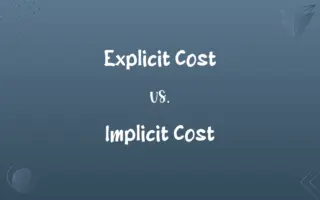Prokaryotic Ribosomes vs. Eukaryotic Ribosomes: Know the Difference

By Shumaila Saeed || Updated on December 25, 2023
Prokaryotic ribosomes are smaller (70S) and simpler than eukaryotic ribosomes, which are larger (80S) and found in more complex cells.

Key Differences
Prokaryotic ribosomes are smaller, typically 70S in size, and are found in simpler, single-celled organisms without a nucleus. Eukaryotic ribosomes are larger, usually 80S, and are present in complex cells with a nucleus.
Shumaila Saeed
Dec 10, 2023
The 70S prokaryotic ribosome is made up of two subunits: 50S and 30S. The 80S eukaryotic ribosome comprises two different subunits: 60S and 40S.
Shumaila Saeed
Dec 10, 2023
Both prokaryotic and eukaryotic ribosomes play a crucial role in protein synthesis, but the process varies slightly due to differences in their RNA and protein content.
Shumaila Saeed
Dec 10, 2023
Many antibiotics selectively target prokaryotic ribosomes, disrupting their function without affecting eukaryotic ribosomes. This is due to structural differences between the two types.
Shumaila Saeed
Dec 10, 2023
In prokaryotes, ribosomes are distributed freely in the cytoplasm, while in eukaryotes, they are found both in the cytoplasm and on the rough endoplasmic reticulum.
Shumaila Saeed
Dec 10, 2023
ADVERTISEMENT
Comparison Chart
Subunit Composition
Made up of 50S and 30S subunits
Comprises 60S and 40S subunits
Shumaila Saeed
Dec 10, 2023
Function in Protein Synthesis
Similar role, but with slight process variations
Similar role, adapted to more complex cell machinery
Shumaila Saeed
Dec 10, 2023
ADVERTISEMENT
Prokaryotic Ribosomes and Eukaryotic Ribosomes Definitions
Prokaryotic Ribosomes
Comprise 50S and 30S subunits.
The 50S and 30S subunits assemble to form prokaryotic ribosomes.
Shumaila Saeed
Dec 03, 2023
Eukaryotic Ribosomes
Comprise 60S and 40S subunits.
The 60S and 40S subunits join together to form eukaryotic ribosomes.
Shumaila Saeed
Dec 03, 2023
Prokaryotic Ribosomes
More sensitive to antibiotics than eukaryotic ribosomes.
Antibiotics like tetracycline inhibit prokaryotic ribosomes.
Shumaila Saeed
Dec 03, 2023
Eukaryotic Ribosomes
Less sensitive to antibiotics than prokaryotic ribosomes.
Most antibiotics do not affect eukaryotic ribosomes.
Shumaila Saeed
Dec 03, 2023
Prokaryotic Ribosomes
Essential for protein synthesis in bacteria.
Prokaryotic ribosomes are crucial for bacterial growth and reproduction.
Shumaila Saeed
Dec 03, 2023
ADVERTISEMENT
Eukaryotic Ribosomes
Larger ribosomes (80S) in eukaryotic cells.
Eukaryotic ribosomes are integral to protein production in human cells.
Shumaila Saeed
Dec 03, 2023
Prokaryotic Ribosomes
Found freely floating in the cytoplasm.
In bacteria, prokaryotic ribosomes synthesize proteins in the cytoplasm.
Shumaila Saeed
Dec 03, 2023
Eukaryotic Ribosomes
Involved in protein synthesis in complex cells.
Eukaryotic ribosomes are found in both animal and plant cells.
Shumaila Saeed
Dec 03, 2023
Prokaryotic Ribosomes
Smaller ribosomes (70S) in prokaryotic cells.
Prokaryotic ribosomes are targets for certain antibiotics.
Shumaila Saeed
Dec 03, 2023
Eukaryotic Ribosomes
Located in the cytoplasm and on the rough endoplasmic reticulum.
Eukaryotic ribosomes on the rough ER synthesize membrane-bound proteins.
Shumaila Saeed
Dec 03, 2023
Repeatedly Asked Queries
What are eukaryotic ribosomes?
They are larger ribosomes found in more complex eukaryotic cells.
Shumaila Saeed
Dec 10, 2023
What makes prokaryotic ribosomes different from eukaryotic ones?
They differ in size, sensitivity to antibiotics, and cellular location.
Shumaila Saeed
Dec 10, 2023
Where are eukaryotic ribosomes found?
In the cytoplasm and on the rough endoplasmic reticulum.
Shumaila Saeed
Dec 10, 2023
What are the subunits of eukaryotic ribosomes?
They comprise 60S and 40S subunits.
Shumaila Saeed
Dec 10, 2023
What are prokaryotic ribosomes?
They are smaller ribosomes found in prokaryotic cells, like bacteria.
Shumaila Saeed
Dec 10, 2023
Are prokaryotic ribosomes simpler than eukaryotic ones?
Yes, they are generally considered simpler.
Shumaila Saeed
Dec 10, 2023
Can prokaryotic ribosomes be inhibited by drugs?
Yes, many antibiotics inhibit prokaryotic ribosomes.
Shumaila Saeed
Dec 10, 2023
Is the function of prokaryotic ribosomes different from eukaryotic ribosomes?
The basic function of protein synthesis is similar, but the process varies slightly.
Shumaila Saeed
Dec 10, 2023
Can antibiotics target eukaryotic ribosomes?
Generally, no. Antibiotics usually target prokaryotic ribosomes.
Shumaila Saeed
Dec 10, 2023
Where are prokaryotic ribosomes located in the cell?
They are found freely floating in the cytoplasm.
Shumaila Saeed
Dec 10, 2023
Do prokaryotic and eukaryotic ribosomes have different RNA content?
Yes, there are differences in their RNA and protein compositions.
Shumaila Saeed
Dec 10, 2023
Are prokaryotic ribosomes involved in protein synthesis?
Yes, they play a key role in protein synthesis in prokaryotic cells.
Shumaila Saeed
Dec 10, 2023
Do eukaryotic ribosomes synthesize proteins?
Yes, they are essential for protein synthesis in eukaryotic cells.
Shumaila Saeed
Dec 10, 2023
Do eukaryotic ribosomes have a more complex structure?
Yes, they are more complex and larger in size.
Shumaila Saeed
Dec 10, 2023
Are eukaryotic ribosomes affected by common antibiotics?
Generally, no, they are less sensitive to antibiotics.
Shumaila Saeed
Dec 10, 2023
Why are eukaryotic ribosomes not targeted by most antibiotics?
Because of their structural differences from prokaryotic ribosomes.
Shumaila Saeed
Dec 10, 2023
Can the differences in ribosomes be used for medical treatments?
Yes, targeting prokaryotic ribosomes is a basis for many antibiotic therapies.
Shumaila Saeed
Dec 10, 2023
What are the subunits of prokaryotic ribosomes?
They consist of 50S and 30S subunits.
Shumaila Saeed
Dec 10, 2023
Share this page
Link for your blog / website
HTML
Link to share via messenger
About Author
Written by
Shumaila SaeedShumaila Saeed, an expert content creator with 6 years of experience, specializes in distilling complex topics into easily digestible comparisons, shining a light on the nuances that both inform and educate readers with clarity and accuracy.









































































